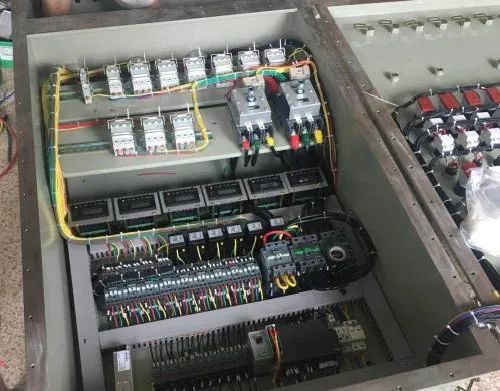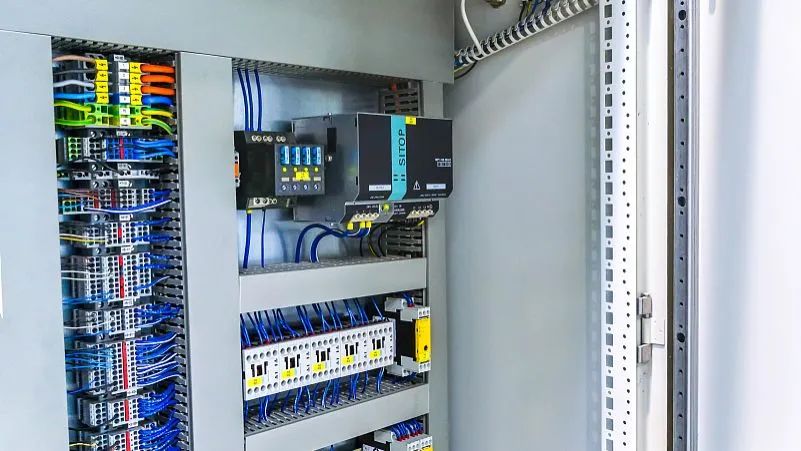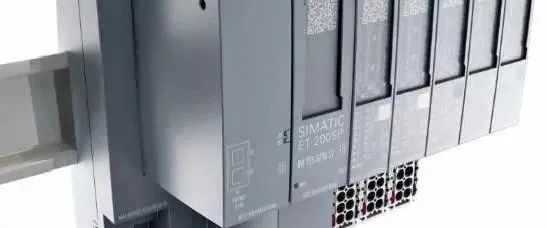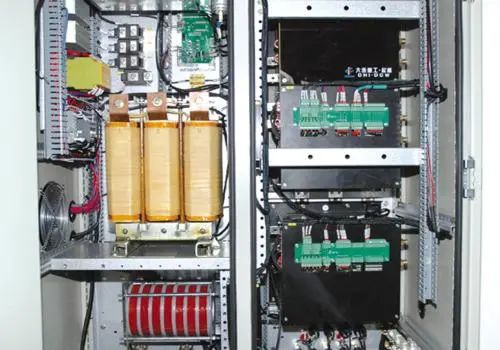PLC (Programmable Logic Controller) application techniques can help improve system reliability, efficiency, and ease of maintenance. Here are some PLC application techniques:
Optimize Input/Output Design:
Minimize unnecessary input/output points to reduce system complexity and cost.
For critical input/output points, use redundant design to improve system reliability.
Use appropriate isolation techniques, such as optical isolation, to reduce the impact of external interference on the PLC.
Clarify Program Structure:
Use a modular programming approach to divide the program into multiple functional blocks for easier debugging and maintenance.
Utilize comments and explanations to detail the function and programming logic of each functional block.
Follow consistent naming conventions for quick identification of variables and functions within the program.
Optimize Data Processing:
For data requiring real-time processing, use direct I/O access to minimize intermediate steps.
For data requiring complex calculations, utilize the PLC’s internal data processing capabilities, such as mathematical and logical operations.
Make efficient use of PLC memory resources to avoid unnecessary data redundancy.
Enhance Communication Efficiency:
Select appropriate communication protocols and interfaces to ensure stable and reliable communication between the PLC and other devices.
Optimize communication parameter settings, such as baud rate, data bits, and stop bits, to improve communication efficiency.
For scenarios involving large data transfers, use batch transfer methods to reduce communication overhead.
Troubleshooting and Diagnosis:
Design a comprehensive troubleshooting and diagnostic system that can monitor the status of the PLC and external devices in real-time.
Integrate self-diagnostic functions into the program to automatically log and alert when anomalies are detected.
Utilize specialized diagnostic tools for troubleshooting to quickly locate and resolve issues.
Safety Protection and Backup:
Encrypt PLC programs to prevent unauthorized tampering or duplication.
Regularly back up PLC programs and data to ensure rapid recovery in case of issues.
Implement safety measures for the PLC and external devices, such as surge protection and anti-static measures.
Continuous Learning and Improvement:

In PLC systems, interference handling is crucial as various interference sources may affect the normal operation of the PLC. Here are some common methods for handling interference in PLC systems:
-
Hardware Anti-Interference Measures:
-
Shielding: Use conductive and magnetically conductive materials to shield key components in the PLC system, such as power transformers, CPUs, and I/O interfaces, to reduce electromagnetic interference.
-
Filtering: Add filters at the PLC’s power input and signal line I/O terminals to reduce or eliminate high-frequency interference signals.
-
Isolation: Use optical isolation technology between the PLC and other devices to minimize common-mode interference caused by ground loop currents.
-
Grounding: Properly configure the grounding system to ensure good grounding of the PLC system, thus reducing common-mode interference.
-
Power Adjustment and Protection: Use a regulated power supply for the PLC to minimize the impact of grid fluctuations. Additionally, add protection circuits for over-voltage, under-voltage, and over-current at the power input.
Software Anti-Interference Measures:
-
Digital Filtering: Implement digital filtering algorithms in the program to process input signals, enhancing the signal-to-noise ratio.
-
Program Limiting Method: For signals prone to interference, apply a limiting method where signals exceeding a certain range are deemed interference and discarded.
-
Set Watchdog Timer (WDT): If the program’s execution time exceeds the WDT limit, it indicates a potential deadlock or interference, triggering an alarm and restarting the program.
-
Fault Diagnosis: The system software regularly checks the external environment for power outages, undervoltage, low lithium battery voltage, and strong interference signals for timely reflection and processing.
Wiring and Installation:
-
Rational Wiring: Separate wiring for signal lines, power lines, and control lines to avoid mutual interference. Use shielded cables where possible and ensure the shielding layer is reliably grounded.
-
Correct Installation: Install the PLC system in a dry, dust-free, non-corrosive environment, away from heat sources and vibration. Ensure proper heat dissipation to prevent overheating that could affect normal operation.
Handling External Interference Sources:
-
Strong Electrical Interference: For interference from the power grid, reduce interference by adding filters or using isolation transformers.
-
Cabinet Interference: For interference within control cabinets, reduce interference by optimizing wiring, minimizing inductive loads, and increasing shielding.
-
Interference from Signal Lines: For various signal transmission lines connected to the PLC control system, use shielded cables and add filters to mitigate interference.
In summary, handling interference in PLC systems requires a comprehensive approach considering hardware, software, wiring, installation, and external interference sources. By taking appropriate measures, the impact of interference on PLC systems can be effectively reduced, enhancing system stability and reliability.

Eliminating inter-capacitance to avoid malfunctions in PLC systems is an important consideration, as inter-capacitance may lead to signal interference or crosstalk, resulting in malfunctions. Here are some suggestions to reduce or eliminate the impact of inter-capacitance:
-
Optimize Wiring:
-
Minimize the length of signal lines, as longer signal lines increase inter-capacitance.
-
Avoid running signal lines parallel to power lines, high-voltage lines, or high-frequency lines to reduce electromagnetic coupling between them.
-
Use shielded cables to minimize the impact of external electromagnetic fields on signal lines.
Use Low-Impedance Power and Grounding:
-
Ensure the PLC system uses low-impedance power to reduce voltage fluctuations on power lines.
-
Utilize a separate grounding system and ensure the grounding resistance of the PLC system is as low as possible to minimize potential differences.
Add Decoupling Capacitors:
-
Add decoupling capacitors (e.g., parallel a capacitor of appropriate value) at the input and output terminals of signal lines to filter out high-frequency noise and reduce the impact of inter-capacitance.
Digital Filtering and Signal Processing:
-
In software programming, apply digital filtering to analog signals to filter out noise and interference caused by inter-capacitance.
-
Process signals using threshold techniques, considering a signal valid only when it exceeds a certain threshold.
Use Optical Isolators:
-
Utilize optical isolators (optocouplers) during signal transmission, which can completely isolate the input and output circuits, thereby eliminating the impact of inter-capacitance.
Avoid Long-Distance Multi-Core Cables:
-
If possible, avoid using long-distance multi-core cables, as this increases inter-capacitance. Consider using short-distance single-core cables or fiber optics for transmission.
Pay Attention to PLC Module Selection and Installation:
-
Select PLC modules with low input impedance and high anti-interference capabilities.
-
Ensure PLC modules are installed in clean, dry environments to avoid corrosion from moisture and dust.
Inspect and Replace Aging Cables:
-
Regularly check the insulation condition and aging of cables, replacing aging cables promptly to reduce inter-capacitance and signal interference.
Use Professional Electromagnetic Compatibility (EMC) Testing Tools:
-
Employ professional EMC testing tools during the design process to detect and evaluate the system’s electromagnetic compatibility and make necessary optimizations based on test results.
Follow Best Practices:
-
Adhere to best practice guidelines and installation recommendations provided by the PLC manufacturer to ensure proper installation and configuration of the system.
Note that the above measures are not fixed and should be adjusted according to the specific PLC system and application scenario. If inter-capacitance issues are severe, a comprehensive approach may be necessary to resolve the problem.

In a PLC (Programmable Logic Controller) system, the selection of output modules is crucial as it directly affects the PLC’s control capabilities and effectiveness over external devices. Here are some suggestions for selecting PLC output modules:
-
Select Based on Power Type:
-
DC Drive Output Modules: Suitable for driving DC loads, such as DC motors and solenoids.
-
AC Drive Output Modules: Suitable for driving AC loads, such as AC motors and lighting equipment.
Select Based on Switching Device Type:
-
Relay Output Modules: Can drive both AC and DC loads, but have slower response times and limited contact lifespans.
-
Transistor Output Modules: Primarily used for driving DC loads, offering fast response times and long lifespans, but are not suitable for driving high-current loads.
-
Thyristor Output Modules: Commonly used for driving AC loads, such as AC motors, providing longer lifespans and better stability.
Consider Output Power and Load Type:
-
Select an appropriate output module based on the actual power required by the load. Ensure the module’s output power exceeds the actual load requirements.
-
Consider the type of load, such as electromagnetic brakes and lighting loads, and select the appropriate output module based on the load characteristics.
Consider Isolation and Protection:
-
If electrical isolation between the PLC and external devices is needed, select output modules with isolation features.
-
Consider protection features of output modules, such as over-current and over-voltage protection, to ensure safe and stable system operation.
Consider Environmental Factors:
-
Select suitable output modules based on the environment in which the PLC system operates. For harsh industrial environments, choose output modules with dust-proof, water-proof, and high-temperature resistance.
Refer to Manufacturer Recommendations:
-
Different manufacturers’ PLC output modules may have different characteristics and applicable ranges. When selecting output modules, refer to the manufacturer’s recommendations and technical documentation for more detailed information and advice.
Consider Cost and Cost-Effectiveness:
-
While meeting system requirements, consider the cost and cost-effectiveness of output modules. Choosing cost-effective output modules can reduce the overall system cost.
In summary, when selecting PLC output modules, comprehensive consideration should be given to power type, switching device type, output power, load type, isolation and protection features, environmental factors, and cost-effectiveness. Through rational selection and configuration, the efficient, stable, and safe operation of the PLC system can be ensured.

Handling overvoltage and overcurrent in inverters focuses on ensuring stable operation and prolonging their lifespan.
For handling overvoltage in inverters, main methods include:
-
Add an inverter circuit on the input side: Excess energy can be fed back to the grid, but this method is expensive and technically complex, typically used only in advanced scenarios.
-
Add appropriate capacitors to the DC link circuit: Capacitors are crucial for voltage stabilization and increasing the circuit’s ability to withstand overvoltage. Increasing the circuit’s capacitance or timely replacing aging capacitors is an effective method for resolving inverter overvoltage issues.
-
Where conditions allow, reduce the power supply voltage: The inverter’s power side generally uses uncontrolled rectifier bridges, resulting in high power supply voltage and high intermediate DC link voltage. Lowering the power supply voltage can reduce the DC link voltage, thereby avoiding overvoltage.
-
Add braking resistors externally to the inverter: When the inverter decelerates, the motor enters regenerative braking, returning high energy to the inverter. This energy is stored in the filter capacitors, increasing the voltage across the capacitors. Adding braking resistors can dissipate this energy, preventing excessive capacitor voltage.
For handling overcurrent in inverters, main methods include:
-
Extend acceleration time: If the inverter’s acceleration time is too short, the torque required by the motor increases, and torque is proportional to current, resulting in high current. Extending acceleration time can reduce current.
-
Lower voltage boost value: During V/f control, excessive voltage boost during startup can also cause overcurrent. Lowering the voltage boost value can prevent overcurrent.
-
Adjust PID parameters: Excessive dynamic response can cause overcurrent. By extending filter time, reducing P values, and increasing I values, dynamic response can be lowered to avoid overcurrent.
-
Inspect cables and motors: Poor insulation of cables or motor stalling can lead to overcurrent. Regularly check cable insulation and ensure motors operate normally to avoid overcurrent.
-
Add isolation transformers on the inverter output side: When an inverter drives multiple small motors, if one small motor encounters an overcurrent fault, it can trip the inverter, affecting the operation of other normal motors. Adding isolation transformers can isolate fault currents, protecting other motors from being affected.
The above methods are for reference only, and specific handling methods should be chosen based on the actual situation and inverter model. During handling, ensure operational safety to avoid further damage to equipment.
In a PLC (Programmable Logic Controller) system, labeling inputs and outputs for easy maintenance is a crucial step. Here are some suggestions to help effectively label inputs and outputs, simplifying the maintenance process:
1. Use Clear and Specific Labels
-
Input Labels: Assign a unique, descriptive label to each input point. For example, if an input point comes from a button, the label could be “START_BUTTON” or “SB1_START”.
-
Output Labels: Similarly, assign a unique label to each output point. For instance, if an output point controls a motor, the label could be “MOTOR_CONTROL” or “MO1_RUN”.
2. Use Graphics and Color Coding
-
Graphics: Use graphical labels (such as symbols or icons) on the PLC’s input/output modules to represent different types of inputs/outputs, like motors, valves, sensors, etc.
-
Color Coding: Different colors can be used to represent different systems or functional areas. For example, all inputs/outputs related to production line A can use blue labels, whereas those related to production line B can use red labels.
3. Create Documentation
-
Input/Output List: Create a detailed input/output list that includes each input/output point’s label, description, function, connected devices, and any relevant notes.
-
Wiring Diagrams: Draw detailed wiring diagrams showing how the PLC’s input/output modules connect to field devices.
-
Logic Diagrams: Create logic or flow diagrams to visually represent how the PLC processes inputs and generates outputs.
4. Field Marking
-
Device Labels: Label each device in the field to indicate which input/output point it connects to the PLC.
-
Cable Marking: Mark cables with their source and destination for quick tracking during maintenance.
5. Use Software Tools
-
PLC Programming Software: Many PLC programming software allow you to add comments or descriptions for input/output points. Utilize these features to provide additional information.
-
Asset Management Software: Use asset management software to track and record detailed information about all PLC input/output points, including maintenance history, replacement dates, etc.
6. Training
-
Ensure all maintenance personnel are familiar with the input/output labeling system and know how to find and use relevant documentation and diagrams.
7. Continuous Updates
-
When changes occur in the system (e.g., adding new devices or modifying existing ones), ensure all relevant input/output labels and documentation are updated accordingly.
By following the above suggestions, you can create a clear and understandable input/output labeling system for the PLC system, greatly simplifying the maintenance process and reducing errors and downtime caused by misunderstandings or confusion.
Diagnosing PLC (Programmable Logic Controller) faults through program logic inference is an effective method that analyzes and locates issues based on the logical relationships and action sequences in the PLC program. Here are some steps and tips to help you diagnose PLC faults through program logic inference:
-
Understand the PLC Program:
-
Before starting, familiarize yourself with the PLC’s programming logic and control strategies. This includes understanding the structure of the PLC program, the instruction set used, and the relationships between various inputs and outputs.
Observe System Actions:
-
Observe the actual operation of the PLC control system, particularly the parts related to the fault. Pay attention to the system’s action process, comparing the fault with the normal situation to identify possible issues.
Analyze Input and Output Signals:
-
Check the PLC’s input and output signals. Ensure the input signals are correct, and the output signals meet expectations, especially focusing on input/output points related to the fault.
Use Back-Checking Method:
-
Apply the back-checking method or reverse reasoning, starting from the fault point and tracing back to find the logical relationships that satisfy its action. Use the input/output correspondence table to find the corresponding PLC output relay and check if its triggering conditions are met.
Trace Program Execution:
-
Use PLC programming software or debugging tools to trace the program’s execution process. Observe the variables, flags, and intermediate results in the program to analyze whether they conform to expected logical relationships.
Check Logical Relationships:
-
Carefully examine the logical relationships in the PLC program, especially those related to the fault. Ensure that the logical conditions are correct and that there are no omissions or errors.
Simulation Testing:
-
Conduct simulation testing in PLC programming software. By simulating input signals, observe the changes in output signals and the execution of the program to further verify the correctness of the logical relationships.
Use Diagnostic Functions:
-
Many PLCs have built-in diagnostic functions that can detect hardware faults and output fault information. By accessing the PLC’s programming software or using specific diagnostic tools, you can read and analyze diagnostic information to determine the specific cause of the fault.
Consider External Factors:
-
When performing program logic inference, consider the influence of external factors. For example, power issues, communication failures, and sensor damage can all lead to PLC faults. Therefore, after ruling out program logic problems, further checks on these external factors are necessary.
Document and Summarize:
-
Document the diagnosis process and results for future reference and experience summary. Additionally, provide feedback on any problems and improvement measures discovered during the diagnosis process to relevant personnel to promote continuous improvement and optimization of the system.
By following these steps and tips, you can diagnose PLC faults through program logic inference and identify the root cause of the issues. It is essential to maintain patience and attention to detail during the diagnosis process, ensuring each step is accurate. Continuous learning and experience accumulation are also necessary to enhance your diagnostic capabilities.